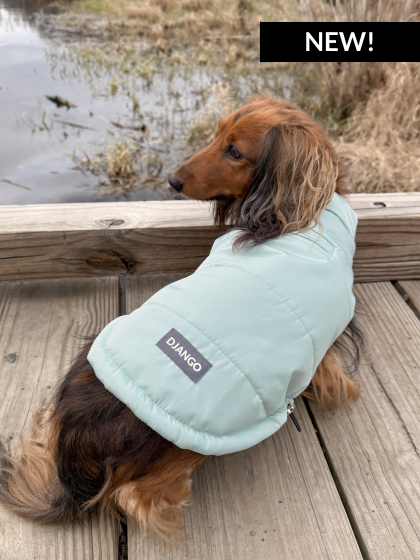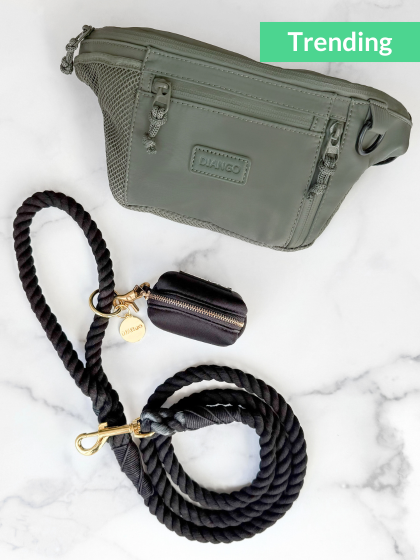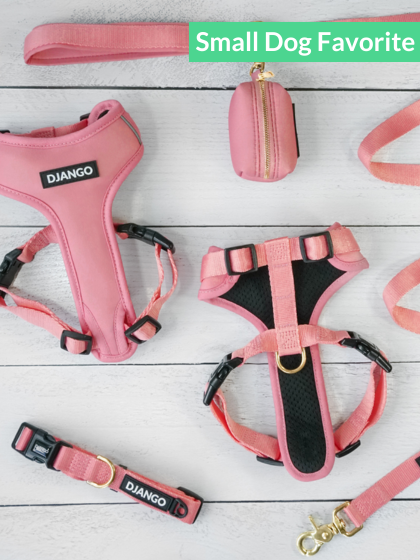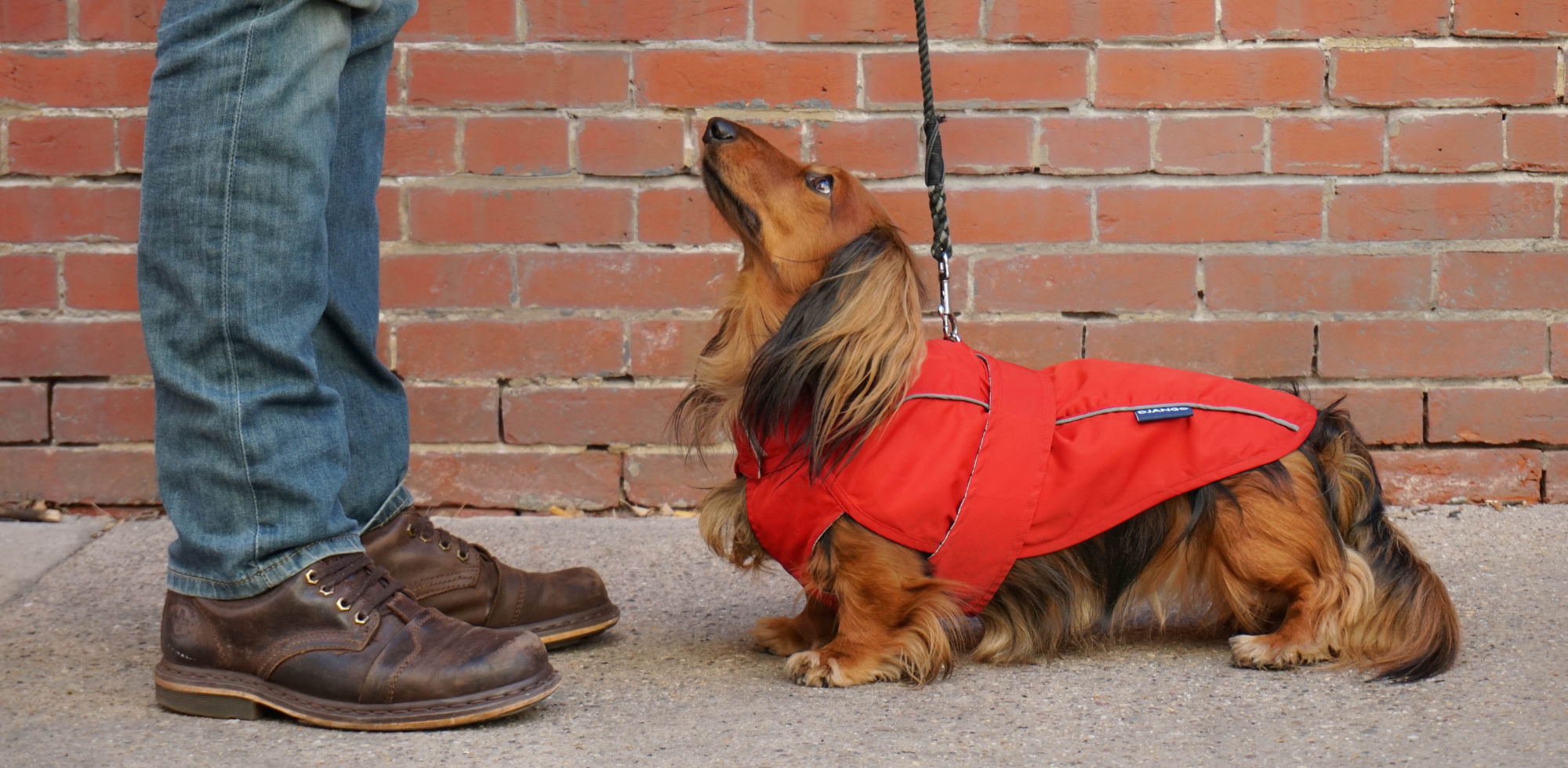Updated October 2025
We (Mike and Steph) have always traveled extensively with our dog Django. When we lived in New York City, Django would regularly ride the subway with us from his comfy DJANGO dog carrier bag, a waxed canvas and leather pet travel tote with a comfy front scoop that dogs can look out of. When we took Django on our honeymoon to France and Italy, he rode at our feet in his airline-friendly pet carrier.
Lately, we've been carrying Django around in his horizontal-style DjangoPack Dog Carrier Backpack. Django had back surgery for Intervertebral Disc Disease one year ago. Although he made a tremendous recovery, his back legs are still weak, and he often struggles to keep up with us on walks and outings. Our doggy backpack is a comfy and convenient place for Django to rest while we continue on our way.
WHY DOG CARRIER BACKPACKS ARE TRENDING
Dog backpack carriers have become increasingly popular in recent years, and for good reason. These pet carriers are incredibly functional and useful in countless settings. Do you love hiking, strolling, or shopping around town with your dog? Do you live in a city, take public transportation, or commute with your pup? Do you have a senior dog with arthritis, a puppy that has not been vaccinated, or a dog recovering from surgery like Django?
Dog backpacks are safe and convenient pet travel carriers where your dog can rest and relax comfortably without slowing you down. They are worn like a standard backpack (on your back) and have a dedicated, secure, and comfy place for your pup to ride.
Let's now explore the two types of dog backpack carriers, vertical and horizontal. We will be discussing why natural position backpack carriers are always the best option for dogs with back or health problems and explain what features you should look for in a horizontal dog backpack carrier.
THE TWO MAIN TYPES OF DOG BACKPACK CARRIERS FOR ADVENTURE AND TRAVEL
There are 2 main types of dog carrier backpacks: vertical dog backpack carriers and horizontal dog backpack carriers.
WHAT ARE VERTICAL DOG BACKPACK CARRIERS?
Traditional vertical dog backpack carriers have your dog positioned inside the carrier in an upright and vertical position. The dog then rides on your back, with his belly against your back, and his head (and sometimes front legs) poking out of the top of the pet carrier near your upper back or neck. There are typically tethers that wrap around the outside of the vertical carrier and buckle into the base.
Vertical dog backpack carriers are arguably photogenic—picture a pup partially stuffed into a little carrier on his owner's back with his paws up in the air while his owner rides a bike down the street. With that said, is it safe and healthy for a dog to be in an unnatural and upright position for an extended period of time? What about dogs that are prone to back problems, arthritic dogs, or other pups with pre-existing conditions? More on this below.
WHAT ARE HORIZONTAL DOG BACKPACK CARRIERS?
Horizontal dog backpack carriers (or natural position backpack carriers) are designed to make adventuring with your dog easier and more comfortable. Unlike vertical-style dog backpacks, these dog carriers allow your canine companion to be on all fours at all times. Your pup will be able to comfortably stand up, turn around, sit and lay down, and shift weight. As a result, there is no stress on your dog's back and spinal cord. Most popular horizontal dog backpack carriers also have small side windows for your dog to poke his head out and take in the scenery.
The DjangoPack Dog Carrier Backpack (pictured below) is a great example of a durable, comfortable, and well-made horizontal backpack for dogs.

"Horizontal backpack carriers mimic how dogs live on a day-to-day basis and might be safer than backpack carriers that support the dog in an abnormal or less customary position," says Dr. Shadi Ireifej, a board-certified veterinary surgeon.
High quality horizontal dog backpack carriers will also feature a secure, padded, and comfortable space for your dog. Look for one with auto-lock zippers that prevent your dog from opening the zippers with his nose, a safety harness clip, and a water- and strain-resistant lining.
TRADITIONAL VERTICAL BACKPACK CARRIERS ARE NOT SAFE FOR ALL DOGS
We spoke to Dr. Jenny Scarano, a canine neurologist at Red Bank Veterinary Hospital in New Jersey and the doctor who performed Django's IVDD back surgery in January 2022. Dr. Scarano confirmed that traditional vertical-style dog carrier bags are never recommended and especially dangerous for dog breeds prone to back problems (more on this below), dogs with sensitive backs, dogs with Intervertebral Disc Disease (IVDD) like Django, and dogs that are obese. This is because the vertical positioning of the dog puts excessive downward pressure and stress on a dog's spine.
WHAT SMALL AND MEDIUM DOG BREEDS ARE PRONE TO BACK PROBLEMS?
While back problems can affect any dog breed, some small and medium sized dog breeds are more at risk because of their genetic makeup, spine length, and skeletal structure.
The following small and medium sized dog breeds should not be put in a vertical-style dog backpack carrier.
- American cocker spaniels
- Basset Hounds
- Beagles
- Bichons frises
- Cavalier King Charles spaniels
- Corgis
- Cotons de Tuléar
- Dachshunds
- Dandie Dinmont terrier
- English bulldogs
- English cocker spaniels
- French bulldogs
- Lhasa Apsos
- Maltese
- Nova Scotia duck tolling retriever
- Pekingese
- Toy and miniature poodles
- Pugs
- Shih Tzus
- Skye Terriers
DOGS PRONE TO OR DIAGNOSED WITH IVDD SHOULD NOT RIDE IN VERTICAL DOG BACKPACK CARRIERS
As we mentioned above, Django's canine neurologist, Dr. Jenny Scarano, confirmed that vertical-style dog backpack carriers should never be used for dog breeds that are prone to Intervertebral Disc Disease (IVDD). This is because they—via gravity and the unnatural vertical position of the dog—put downward pressure and stress on a dog’s spine.
IVDD is a disease that affects the spinal cord of dogs. It causes the intervertebral discs between the bones of the spinal column to bulge or burst. IVDD is most common in chondrodystrophic breeds like dachshunds, corgis, and basset hounds that have long backs and short legs. IVDD can cause pain, difficulty walking, loss of bladder or bowel control, and even partial or full leg paralysis if not corrected with back surgery.
“We know that dogs with IVDD have microscopic changes to their discs, so it is safe to assume that vertical backpack carriers are unsafe for dogs with pre-existing spinal issues,” Dr. Ireifej emphasizes.
VERTICAL BACKPACK CARRIERS ARE DANGEROUS FOR DOGS WITH OTHER SPINAL DISORDERS
Dr. Ireifej says vertical backpack carriers are also unsafe for dogs with spinal tumors and cysts. They are dangerous for dogs with spinal birth defects like Wobbler’s syndrome (Cervical spondylomyopathy).
Dogs with Cauda Equina Syndrome (lumbosacral stenosis) should not use a vertical dog carrier either. Cauda Equina Syndrome is caused by compressed spinal nerve roots. It results in painful and severe progressive arthritis in the joint at the bottom of your pup's spine. Senior dogs with long backs like Beagles are the most at risk for developing Cauda Equina Syndrome.
Dogs that have undergone spinal cord surgery (e.g., hemilaminectomy or dorsal laminectomy) also should not be carried in vertical dog backpacks.
WHAT OTHER PRE-EXISTING HEALTH CONDITIONS MAKE VERTICAL DOG BACKPACK CARRIERS AN UNSAFE OPTION FOR A DOG?
Stewart says brachycephalic dog breeds may struggle to breathe in a vertical backpack carrier. That is because they have slit-like nostrils and dangerously narrow windpipes and tend to get overheated very easily.
Dr. Scarano adds that overweight and obese dogs cannot handle additional stress on their spine, so they should also avoid traditional vertical dog carriers.
Dogs with behavioral problems like confinement anxiety should not be carried in a vertical dog carrier bag either. Indeed, these pups may be uncomfortable in any pet carrier (backpack or otherwise). Here's a great guide on how to help any dog get comfortable riding in a pet carrier.
“Some dogs feel strange being lifted and not having their feet on the ground. It is a big change to their senses and this sort of mental stimulation can have a big impact on their minds,” Stewart says.
"Having their freedom of movement restricted by using a carrier backpack can also be stressful for dogs. So make sure they are fully conditioned and accepting before their first ride.” Teach your dog to enjoy riding in a dog backpack carrier here.
FEATURES TO LOOK FOR IN A HORIZONTAL DOG BACKPACK CARRIER
Whether you are hiking through the woods, riding urban transport, or climbing flights of stairs, a horizontal dog carrier backpack should work for any activity, confirms Paula Stewart, director at The Animal Talent.
Before getting a horizontal backpack carrier for your dog, look at what materials it is made from and how big it is. Here is what you should look for in a natural position dog bag carrier.
- SIZING. Your dog should have enough room to stand up, turn around, sit down, and shift weight in the horizontal dog backpack carrier.
- DIMENSIONS. Pick a horizontal dog backpack carrier based on your dog’s height and back length.
- Back length. To measure your dog's back length, run a tape measure from the back of your pup's neck, where a dog collar rests naturally, down his spine and to the base of his tail.
- Height. To ensure your dog fits into the backpack carrier when the zipper is fully closed, measure your pup from the floor to the top of his head. Plan to leave the zipper open and have your dog stick his head out at all times? You will only need to measure from the floor to your dog’s withers. This is the tallest point between your dog’s shoulder bones and the back of his neck.
- WEIGHT. Pick a dog backpack carrier with a weight limit that is appropriate for your pup. With that said, keep in mind that weight is not always the best size metric for a dog carrier bag. For example, a 25-pound French bulldog has much different proportions than a 25-pound whippet. While both dogs look the same on a scale, they might not fit into the same size backpack carrier. For this reason, knowing your dog's dimensions (back length and height) will give you the best indication of fit.
- SAFETY. Ensure the horizontal dog carrier backpack has auto lock zippers and a safety leash tether.
- FUNCION & CONVENIENCE. The dog backpack carrier should have extra pockets for poop bags, dog treats, and portable dog water bottles.
- COMFORT. Padding of the backpack interior base is key because it can absorb shock and prevent your pup from experience any discomfort during use. Additionally, the interior lining of the backpack should be soft and silky for your pup.
- VENTILATION. Look for mesh windows to prevent your dog from overheating.
- OTHER CONSIDERATIONS. Choose a backpack made from lightweight and very durable materials. Additionally, the main fabric should be water-repellent to ensure your pup stays dry in the chance of a rain shower.
THE BOTTOM LINE
Horizontal dog backpack carriers (or natural position backpack carriers) are hands-down the best option for any dog. These backpacks allow dogs to ride in a natural position on all fours and remain comfortable at all times.
Vertical-style backpacks where pups sit in an upright position put undue stress on dogs' spines. These backpacks are especially unsafe for dogs with sensitive backs, IVDD, arthritis, obesity, and many other pre-existing health conditions.














